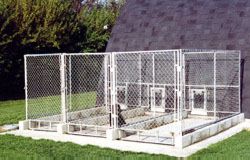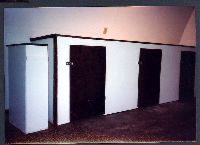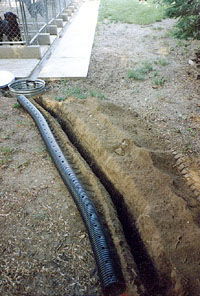| See A Video Tour of A Completed Kennel |
|
 Figures
1-4 Click
here for larger (220k) print version of this diagram. Figures
1-4 Click
here for larger (220k) print version of this diagram.(It appears in a new window, print window, then close window to return here.) |
|
The Floor Now that we have picked the ideal location, lets
overview the size and surface of the structure floor as illustrated in
Figure 1. For the retriever breeds, I feel a 4x12' kennel
is a good size to start with. A dog will have plenty of room to walk,
yet the area is not so large that shoveling snow and general cleaning
will be difficult. Lets remember that a kennel is not an exercise run;
it's an area where your dog can get fresh air and use a corner for
a bathroom. If you allow your dog to exercise outside the kennel twice
a day, your dog should condition itself to use the facility outside and
not mess up the kennel floor. For the smaller run, you should use a smooth
concrete floor. If you are going to own the high test breeds;shorthairs,
Brittanys, etc. where the dogs have a tendency to pace, a larger run should
be laid out. It is not uncommon to use 6x12' or 6x24' layouts
which may help stool stomping problems that occur with the more active
breeds. With larger floor areas, a light broom concrete surface is important
to eliminate injury from dogs slipping on a smooth surface. If the surface
is too rough, it can cause irritation or even cut the pads on a dog's
feet. The concrete is reinforced with rebar or mesh and is poured four inches thick with a one quarter inch slope for each foot of run to the front entrance. A two inch by six inch gutter is formed at the base of the entrance to allow for a septic system drain. A three-foot side walk is built at the entrance. An added feature to the floor is the construction of concrete blocks for a kennel wall base. The blocks make for easy kennel cleaning and also saves wear and tear on the kennel walls. The blocks are laid directly on the concrete slab. Upon completion, each block is filled three-quarters full of sand, then concrete is smoothed over the remaining void. Each end block is left open for final placement of the kennel walls. Kennel Walls The kennel wall fabric should be 9 gauge in 6x12'
or 6x24' length walls which can be purchased from the local lumber
yard or fence company. If you are a do-it yourself kind of guy, most fence
companies will sell you the components with easy installation instructions.
Be sure to purchase 11 gauge fabric for a top cover. This is a must for
keeping dogs away from your female in heat or stopping the male jumper. As Figure 2 illustrates, the kennel entrance
door is designed with a full swing opening for easy snow removal. A one
foot chain hooped with a bolt snap or padlock can be used for added security.
The end wall against the building can be covered
by 1x2" welded wire. Note you never want to leave a building wall
exposed to a dog due to the simple fact that the surface will become
a chew toy for most animals. The DoghouseIs the doghouse going to be free standing or built
in a garage or building? I think the biggest advantage of the doghouse
constructed in a building is having access to your dog during poor weather
and the added warmth or cooling effect of a double-walled structure. Figure 3 illustrates an outside doghouse constructed with 2x4" or 2x6" framing with three inches or more styrofoam insulation. Stay away from fiberglass insulation for an outside doghouse unless you plan to vent the walls for removal of moisture. Once fiberglass gets wet, you lose all insulation qualities. One-half inch painted CDX plywood should be used on all inside and outside surfaces. Cover all chewable doghouse corners with galvanized sheet rock corner molding. An optional three-quarter-inch plywood winter insert can be added to create an area to retain your dog bedding. For the bedding, use pine shavings or marsh hay. Stay away from cedar chips, which can goof up a dog's nose, and straw which breaks down into fine pieces. You can now purchase reliable electric heat mats which eliminate the cleanup hassle of bedding, but, more importantly, provide an environment as comfortable as your living quarters. One often important feature needs to be considered in that you are providing a clean, dry bedding surface area and a well-insulated house. But, this is all in vain if you do not install a weather-proof dog door.
Rather than building a removable roof on the inside
doghouse, construct an inside door with three-quarter inch plywood with
the grain of the wood running vertical to the floor. A 20x30" door
hinged with two |
|
|
|
|
|
Figure 5
|
Kennel Drainage Proper drainage of water and waste material in a
kennel is necessary for good sanitation, general cleanliness of the dogs,
and as an aid in bacteria and parasite control. The type of septic system
presented is intended for a concrete run with a gutter leading to a container
and is not effective for gravel or sand runs. Be sure to check local building
codes before beginning this construction project. Drainage from the outside run goes into a gutter
across the end of the run. The gutter slopes so the waste is carried to
a large metal garbage can as shown in Figure 5. One-half inch holes
are drilled down the can and the bottom is cut out. A 6x4" inlet
hole is cut on the top edge to allow access of waste from the kennel floor.
The can is installed approximately two inches higher than ground level. Next, clean rock is placed around the tank and in
the bottom 18 inches of the trench. A four-inch perforated sewer pipe
is placed on the rock and butted up to the outside of the sewer tank,
two inches of rock over the top of the pipe, a layer of newspaper, and
the soil back fill completes the project. The key to this system functioning properly is the
soils must have an absorption or percolation rate between 0.1 and 60 minutes
per inch or in other words, sand or sandy loam soils. A simple soil textures
test by your local soil conservation service will inform you of the local
soil conditions. This system will not function in the winter in northern
states if the ground freezes. To avoid frequent clean-out of tank, use
a large aluminum shovel and garden hoe to pick up surplus stool. Sweep
only hair and by-product in system. Helpful Hints • Make a pre-construction
sketch of your kennel plans. |
|
The above article appeared in the June/July 1996 issue of Gun Dog Magazine.The author Carl Altenbernd has a Masters Degree in Community and Regional Planning. He has twenty plus years of professional planning and financial lending experience. Carl is the owner of Gun Dog Kennels and Gun Dog House Door® Company with 25 years experience training dogs, he also has been published in Gun Dog Magazine 18 times. |
|
TIPS
Videos and Articles on Kennel Design and Dog Training.
INSTALL
Pet Door Installation Instructions
with Training Tips.
BLOG
News, Features and More! Come Visit.
Thank You, Lance & Marcie
|
|
1-800-789-0203 • 701-354-7700 • Fax
701-354-0117
13835 34th St NW • Bismarck, ND 58503 International 701-354-7700 Copyright © 1992-2024 Gun Dog House Door® Inc. |

 A
Complete Kennel System!
A
Complete Kennel System!
 An
inside-the-building doghouse has similar features to the outside unit
as far as building materials go. It includes 2x4" or 2x6" framing,
a half-foot painted CDX plywood and insulation as shown in Figure 4.
For the dog's bed, lay a 2x4" on edge with a half-inch plywood covering
and three inches of styrofoam nailed between the 2x4" for the floor
insulation. A dog sleeping on plywood or an electric heat mat is much
more healthy since carpet or other materials retain moisture, dirt and
bacteria which can cause coat or other health problems.
An
inside-the-building doghouse has similar features to the outside unit
as far as building materials go. It includes 2x4" or 2x6" framing,
a half-foot painted CDX plywood and insulation as shown in Figure 4.
For the dog's bed, lay a 2x4" on edge with a half-inch plywood covering
and three inches of styrofoam nailed between the 2x4" for the floor
insulation. A dog sleeping on plywood or an electric heat mat is much
more healthy since carpet or other materials retain moisture, dirt and
bacteria which can cause coat or other health problems.
 Final
treatment of the waste water is completed in the drainfield trench. The
trench is constructed by making a level excavation six inches wide, ten
feet long, and three feet deep. A trencher works well for this job.
Final
treatment of the waste water is completed in the drainfield trench. The
trench is constructed by making a level excavation six inches wide, ten
feet long, and three feet deep. A trencher works well for this job.

